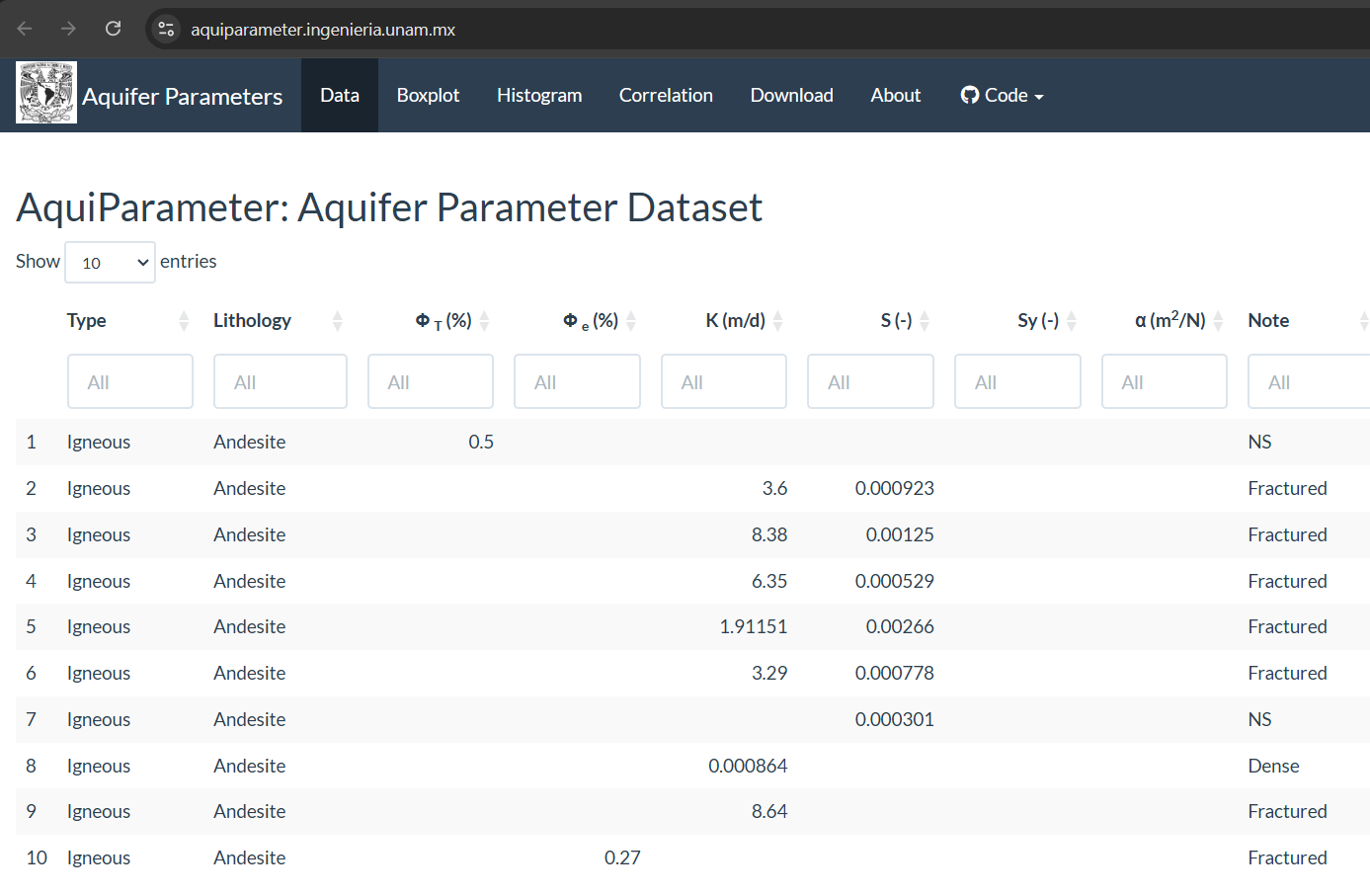Abstract
Groundwater represents a strategic resource for human development worldwide, and therefore, its instruction plays a key
role in the current geoscientific, engineering and environmental educational landscape. For any hydrogeology student, it is crucial to understand groundwater flow fundamentals, bridging a descriptive lithological feature into a quantitative hydraulic property, through a mandatory topic in class: The Hydrogeological Parameters (HP). Thus, we developed "Aquiparameter" a cost-free Web platform for rapid access, data visualization and statistical analysis for 6,000+HP records https://aquiparameter.ingenieria.unam.mx/). The aim of this teaching paper is to present a new didactic approach based
on the design of a series of practical exercises focused on solving quantitative problems in hydrogeology. These exercises facilitate the teaching of HP through active learning, visually demonstrating the statistical variability of hydrogeological parameters in granular and fractured media using "Aquiparameter". They also promote data analysis and visualization, an increasingly required complement for students in STEM and geoscience fields, as it enhances understanding of complex processes, enables the detection of patterns and trends in large datasets, and prepares new generations to tackle modern
challenges in an innovative, systematic, and analytical way.
References
Báez-Reyes, H. (2021). AquiParameter: Base de datos abierta de parámetros hidrogeológicos. Compilación y análisis estadístico usando R. Tesis de licenciatura, Ing. Geológica, Facultad de Ingeniería, UNAM.
Baez‐Reyes, H., Hernández‐Espriú, A. (2024). AquiParameter—A Novel Interactive Web‐Based Tool for Statistical Assessment of Hydrogeological Parameters. Groundwater.
Boyd, E. A., Lazar, K. B., Moysey, S. (2024). Big data to support geoscience recruitment: Novel adoption of topological data analysis in geoscience education. Bulletin, 136(3-4), 1458-1468.
Custodio, E., Llamas, M. R. (1983). Hidrología subterránea, 2da Edición, Omega, Barcelona, España.
Fetter, C. W. (2018). Applied hydrogeology. Waveland Press, Ohio, EUA. Food and Agriculture Organization (FAO). (2016). AQUASTAT Database: Mexico - Country Profile. http://www.fao.org/nr/water/aquastat/main/index.stm.
Freeze, A., Cherry, J. (1979). Groundwater, Prentice Hall, NJ, EUA.
Google (2023). Google Colaboratory. https://colab.research.google.com
Keller, C. K., Allen-King, R. M., O'Brien, R. (2000). A framework for integrating quantitative geologic problem solving into courses across the undergraduate geology curriculum. Journal of Geoscience Education, 48(4), 459-463.
Ma, J., Li, D., Wang, M. (2021). The Evaluation of the Hydrogeological Parameters of a Field Pumping Test within Multi-layer Unconfined
Pebble Aquifers: A Case Study. KSCE Journal of Civil Engineering, 25, 4018-4031.
Siebert, S., Burke, J., Faures, J. M., Frenken, K., Hoogeveen, J., Döll, P., y Portmann, F. T. (2010). Groundwater use for irrigation–a global inventory. Hydrology and earth system sciences, 14(10), 1863-1880.
Omar, P. J., Gaur, S., Dwivedi, S. B., Dikshit, P. K. S. (2020). A modular three-dimensional scenario-based numerical modelling of groundwater flow. Water Resources Management, 34(6), 1913-1932.
Prince, M. (2004). Does active learning work? A review of the research. Journal of engineering education, 93(3), 223-231.
Python Software Foundation. (2024). Python Language Reference (version 3.12). https://www.python.org
Shiklomanov, I. A. (1993). World fresh water resources. In P. H. Gleick (Ed.), Water in Crisis: A Guide to the World's Fresh Water Resources (pp. 13-24). Oxford University Press.
Styers, D. M. (2018). Using big data to engage undergraduate students in authentic science. Journal of Geoscience Education, 66(1), 12-24.
Sullivan, M. (2018). Fundamentals of statistics: Informed decisions using data. Pearson, Boston, EUA.
Trauth, M. H. (2022). Python Recipes for Earth Sciences. Springer Texbooks in Earth Sciences, Geography and Environment, Springer.
Van Loon, A. F. (2019). Learning by doing: enhancing hydrology lectures with individual fieldwork projects. Journal of Geography in Higher Education, 43(2), 155-180.

This work is licensed under a Creative Commons Attribution-NonCommercial 4.0 International License.
Copyright (c) 2024 Universidad Nacional Autónoma de México

